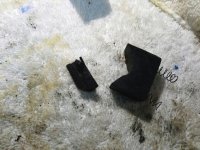Hi all,
I am currently stripping my 1952 Churchill NB surface grinder and upon taking the bottom table off I inspected the way oilers. These sit on springs in pockets in the ways and are fed hydraulically with oil. Both have broken or damaged springs and one is split. It's difficult to access what material it is. It's very light like balsa wood light or fibreglass and a sliver can be easily cut from it.
I'd like to know if anyone is aware of what material it may so I can make replacements or alternatively a material that could be used as this was?

I am currently stripping my 1952 Churchill NB surface grinder and upon taking the bottom table off I inspected the way oilers. These sit on springs in pockets in the ways and are fed hydraulically with oil. Both have broken or damaged springs and one is split. It's difficult to access what material it is. It's very light like balsa wood light or fibreglass and a sliver can be easily cut from it.
I'd like to know if anyone is aware of what material it may so I can make replacements or alternatively a material that could be used as this was?


